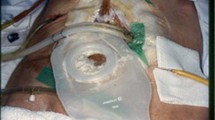Abstract
Background
Expanded adipose-derived stem cells (ASC) have been shown to be effective in treating Crohn’s patients with enterocutaneous fistulas. It is possible that unexpanded cells corresponding to the stromal vascular fraction (SVF) may also be effective.
Materials and methods
A subpopulation of patients from a previous proof-of-concept phase I study with enterocutaneous fistulas received autologous expanded ASCs. The same selection criteria for inclusion were applied to patients who underwent SVF implantation to treat enterocutaneous fistulas. After tract curettage, cell suspensions (either SVF cells from lipoaspirate or expanded ASCs) were injected into the tract walls, and the fistulous tract was sealed with fibrin adhesive (with or without cells).
Results
In the series that received ASCs, four fistulas could be evaluated, and cure was achieved in three out of four cases. In the series that received SVF cells, four fistulas were evaluated, with cure achieved in one out of four cases.
Conclusions
Although a comparison of case series cannot be considered firm evidence, a therapeutic protocol that uses expansion prior to implantation does seem to be more effective than one that uses SVF cells directly from a lipoaspirate sample.
Similar content being viewed by others
References
Caprilli R, Gassull MA, Escher JC, Moser G, Munkholm P, Forbes A, Hommes DW, Lochs H, Angelucci E, Cocco A, Vucelic B, Hildebrand H, Kolacek S, Riis L, Lukas M, de Franchis R, Hamilton M, Jantschek G, Michetti P, O’Morain C, Anwar MM, Freitas JL, Mouzas IA, Baert F, Mitchell R, Hawkey CJ (2006) European Crohn’s and Colitis Organisation: European evidence based consensus on the diagnosis and management of Crohn’s disease: special situations. Gut 55(Suppl 1):i36–i58
Levy C, Tremaine WJ (2002) Management of internal fistulas in Crohn’s disease. Inflamm Bowel Dis 8:106–111
Sands BE, Anderson FH, Bernstein CN, Chey WY, Feagan BG, Fedorak RN, Kamm MA, Korzenik JR, Lashner BA, Onken JE, Rachmilewitz D, Rutgeerts P, Wild G, Wolf DC, Marsters PA, Travers SB, Blank MA, van Deventer SJ (2004) Infliximab maintenance therapy for fistulizing Crohn’s disease. N Engl J Med 350:876–885
Zuk PA, Zhu M, Mizuno H, Huang J, Futrell W, Katz AJ, Benhaim P, Lorenz HP, Hedrick MH (2001) Multilineage cells from human adipose tissue: implications for cell-based therapies. Tissue Eng 7:211–228
De Ugarte DA, Alfonso Z, Zuk PA, Elbarbary A, Zhu M, Ashjian P, Benhaim P, Hedrick MH, Fraser JK (2003) Differential expression of stem cell mobilization-associated molecules on multi-lineage cells from adipose tissue and bone marrow. Immunol Lett 89:267–270
Garcia-Olmo D, Garcia-Arranz M, Garcia LG, Serna E, Fernandez-Blanco I, Asensio L, Rodríguez-Montes JA, Lima Pinto F, Herreros D, García-Sancho L (2003) Autologous stem cell transplantation for treatment of rectovaginal fistula in perianal Crohn’s disease: a new cell-based therapy. Int J Colorectal Dis 18:451–454
Garcia-Olmo D, Garcia-Arranz M, Herreros D, Pascual I, Peiro C, Rodriguez-Montes JA (2005) A phase I clinical trial of the treatment of Crohn’s fistula by adipose mesenchymal stem cell transplantation. Dis Colon Rectum 48:1416–1423
Gasche C, Scholmerich T, Brynskov J, D’Haens G, Hanauer SB, Irvine EJ, Jewell DP, Rachmilewitz D, Sachar DB, Sandborn WJ, Sutherland LLR (2000) A simple classification of Crohn’s I disease: report of the Working Party for the World Congresses of Gastroenterology—Vienna 1998. Inflamm Bowel Dis 6:8–15
Daniels E (2004) Adipose derived cell therapy—the future data series in regenerative cell therapy. MicroPore Biosurgery, San Diego
McIntosh K, Zvonic S, Garrett S, Mitchell JB, Floyd ZE, Hammill L, Kloster A, Di Halvorsen Y, Ting JP, Storms RW, Goh B, Kilroy G, Wu X, Gimble JM (2006) The immunogenicity of human adipose-derived cells: temporal changes in vitro. Stem Cells 24:1246–1253
Acknowledgements
The authors acknowledge the technical support from the Plastic Surgery Department (Drs. Casado, Leyva, Recatero, and Salvatierra) of La Paz University Hospital. We also thank the assistance and support from our hospital and the funding from Cellerix S.A.
Author information
Authors and Affiliations
Corresponding author
Rights and permissions
About this article
Cite this article
Garcia-Olmo, D., Herreros, D., Pascual, M. et al. Treatment of enterocutaneous fistula in Crohn’s Disease with adipose-derived stem cells: a comparison of protocols with and without cell expansion. Int J Colorectal Dis 24, 27–30 (2009). https://doi.org/10.1007/s00384-008-0559-0
Accepted:
Published:
Issue Date:
DOI: https://doi.org/10.1007/s00384-008-0559-0




